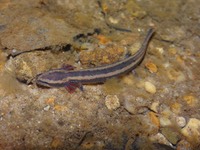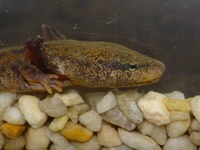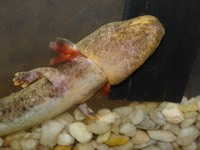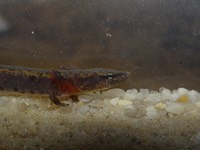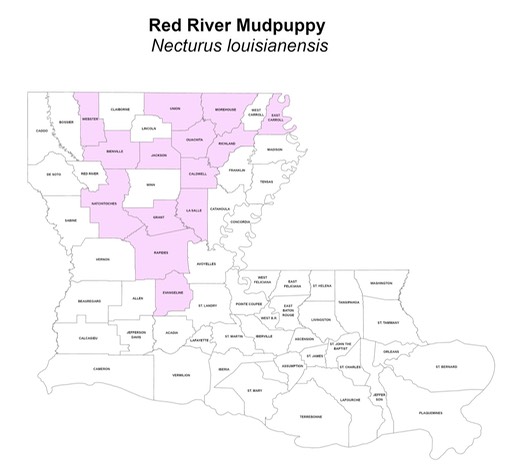
*The colored areas of the map above represent parishes with currently known records for the given species (Source: Jeff Boundy, LA Dept. of Wildlife and Fisheries). By no means does it represent the full range of the species in the state, nor does it necessarily mean that a species can be found throughout the parish with the record. This is provided as a guide to where you might be able to find these species in the state and to aid in identification. A descriptive explanation of the range of each species can be found in the text below.
Other Common Names:
Subspecies: No subspecies recognized.
Adult Description: Stout-bodied salamander (maximum 12.1”) with small eyes and conspicuous pink to red feathery gills on either side behind head. A black stripe often runs from snout through eye to base of gills. Overall color is usually a shade of brown, but sometimes gray, with large black spots and smaller pale or yellow spots scattered throughout body and tail. Pattern often darker on sides. Tail is laterally compressed, often with a brighter yellow edge on both sides of tail end. Four toes on all four limbs. 15–16 costal grooves. Belly is typically gray to white, but sometimes tan, and may be scattered with dark spots or markings or be without pattern, at least down middle.
Similar Species:
Species Range: Red River and adjacent drainages from northeastern Oklahoma, southeastern Kansas, and sothern Missouri south through Arkansas to central Louisiana.
Louisiana Range: Central and northern Louisiana.
Adult Habitat: Clear, flowing streams and rivers with sandy bottoms and plentiful submerged root tangles, deadwood, and leaf packs. They can also be found in impoundments of these same streams and rivers.
Natural History: Red River Mudpuppies are nocturnal but may be active during the day in deep, murky water. They prey upon a wide variety of aquatic invertebrates, including crawfish, clams, and insects, as well as vertebrates like smaller salamanders and fish. They will also consume salamander and fish eggs. Fish are likely the most important predators, though it has been suggested that reduced activity of Mudpuppies in summer when fish are most active is an anti-predator mechanism. Other predators include watersnakes, wading birds, and otters. In spring, females deposit clutches of up to 91 eggs in depressions on the substrate under submerged objects, often logs or other large debris. Females guard their nests, and eggs typically hatch in 1–2 months. Maturity occurs in 5–6 years. Maximum wild longevity is unknown, but likely exceeds 10 years. Captives have lived over 30 years.
Best Time and Place to Observe: Red River Mudpuppies are secretive and primarily nocturnal and not often observed without trapping. They are most active in cooler weather, particularly after mild to moderate rains, from fall through spring.
Global Conservation Status: Red River Mudpuppies have a relatively wide distribution in the eastern North America, a presumed large population, and tolerate a degree of habitat modification, and thus, are listed as Least Concern by the IUCN Red List. Their NatureServe Global Conservation Status Rank is G5 (Secure).
Federal Conservation Status: None.
Louisiana Conservation Status: Red River Mudpuppies have a ranking of S2 (imperiled because of rarity – 6-20 known extant populations) in Louisiana. In Louisiana, Red River Mudpuppies have a State Protection Status of ‘prohibited’, meaning possession or harvest of this species is illegal.
*** If you live in the range of this species in Louisiana and believe you may have observed this species please let me know (take a picture if possible), as there may be more unknown populations in the state.***
Author's Remarks: I have found many individuals of this species from four different sites in central Louisiana in early 2017.
